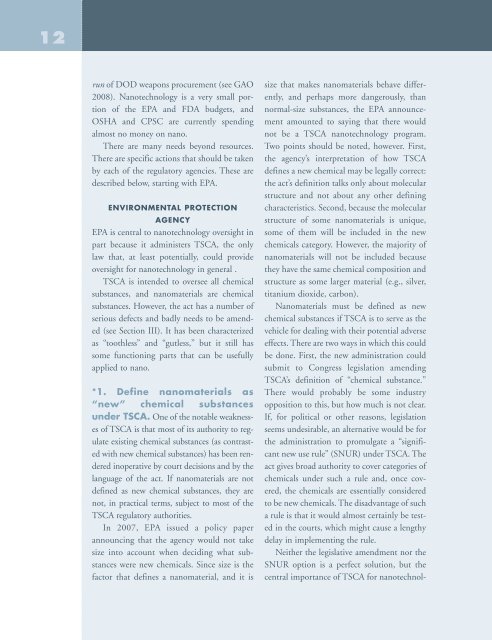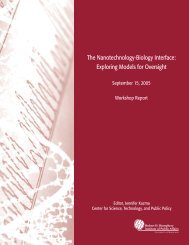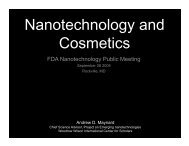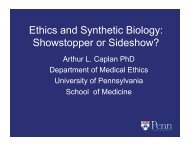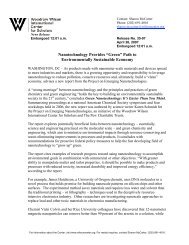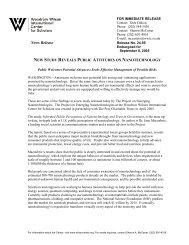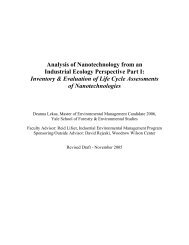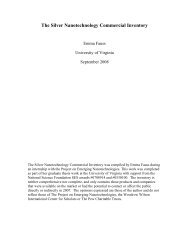nanotechnology oversight - Project on Emerging Nanotechnologies
nanotechnology oversight - Project on Emerging Nanotechnologies
nanotechnology oversight - Project on Emerging Nanotechnologies
Create successful ePaper yourself
Turn your PDF publications into a flip-book with our unique Google optimized e-Paper software.
12<br />
run of DOD weap<strong>on</strong>s procurement (see GAO<br />
2008). Nanotechnology is a very small porti<strong>on</strong><br />
of the EPA and FDA budgets, and<br />
OSHA and CPSC are currently spending<br />
almost no m<strong>on</strong>ey <strong>on</strong> nano.<br />
There are many needs bey<strong>on</strong>d resources.<br />
There are specific acti<strong>on</strong>s that should be taken<br />
by each of the regulatory agencies. These are<br />
described below, starting with EPA.<br />
ENVIRONMENTAL PROTECTION<br />
AGENCY<br />
EPA is central to <str<strong>on</strong>g>nanotechnology</str<strong>on</strong>g> <str<strong>on</strong>g>oversight</str<strong>on</strong>g> in<br />
part because it administers TSCA, the <strong>on</strong>ly<br />
law that, at least potentially, could provide<br />
<str<strong>on</strong>g>oversight</str<strong>on</strong>g> for <str<strong>on</strong>g>nanotechnology</str<strong>on</strong>g> in general .<br />
TSCA is intended to oversee all chemical<br />
substances, and nanomaterials are chemical<br />
substances. However, the act has a number of<br />
serious defects and badly needs to be amended<br />
(see Secti<strong>on</strong> III). It has been characterized<br />
as “toothless” and “gutless,” but it still has<br />
some functi<strong>on</strong>ing parts that can be usefully<br />
applied to nano.<br />
*1. Define nanomaterials as<br />
“new” chemical substances<br />
under TSCA. One of the notable weaknesses<br />
of TSCA is that most of its authority to regulate<br />
existing chemical substances (as c<strong>on</strong>trasted<br />
with new chemical substances) has been rendered<br />
inoperative by court decisi<strong>on</strong>s and by the<br />
language of the act. If nanomaterials are not<br />
defined as new chemical substances, they are<br />
not, in practical terms, subject to most of the<br />
TSCA regulatory authorities.<br />
In 2007, EPA issued a policy paper<br />
announcing that the agency would not take<br />
size into account when deciding what substances<br />
were new chemicals. Since size is the<br />
factor that defines a nanomaterial, and it is<br />
size that makes nanomaterials behave differently,<br />
and perhaps more dangerously, than<br />
normal-size substances, the EPA announcement<br />
amounted to saying that there would<br />
not be a TSCA <str<strong>on</strong>g>nanotechnology</str<strong>on</strong>g> program.<br />
Two points should be noted, however. First,<br />
the agency’s interpretati<strong>on</strong> of how TSCA<br />
defines a new chemical may be legally correct:<br />
the act’s definiti<strong>on</strong> talks <strong>on</strong>ly about molecular<br />
structure and not about any other defining<br />
characteristics. Sec<strong>on</strong>d, because the molecular<br />
structure of some nanomaterials is unique,<br />
some of them will be included in the new<br />
chemicals category. However, the majority of<br />
nanomaterials will not be included because<br />
they have the same chemical compositi<strong>on</strong> and<br />
structure as some larger material (e.g., silver,<br />
titanium dioxide, carb<strong>on</strong>).<br />
Nanomaterials must be defined as new<br />
chemical substances if TSCA is to serve as the<br />
vehicle for dealing with their potential adverse<br />
effects. There are two ways in which this could<br />
be d<strong>on</strong>e. First, the new administrati<strong>on</strong> could<br />
submit to C<strong>on</strong>gress legislati<strong>on</strong> amending<br />
TSCA’s definiti<strong>on</strong> of “chemical substance.”<br />
There would probably be some industry<br />
oppositi<strong>on</strong> to this, but how much is not clear.<br />
If, for political or other reas<strong>on</strong>s, legislati<strong>on</strong><br />
seems undesirable, an alternative would be for<br />
the administrati<strong>on</strong> to promulgate a “significant<br />
new use rule” (SNUR) under TSCA. The<br />
act gives broad authority to cover categories of<br />
chemicals under such a rule and, <strong>on</strong>ce covered,<br />
the chemicals are essentially c<strong>on</strong>sidered<br />
to be new chemicals. The disadvantage of such<br />
a rule is that it would almost certainly be tested<br />
in the courts, which might cause a lengthy<br />
delay in implementing the rule.<br />
Neither the legislative amendment nor the<br />
SNUR opti<strong>on</strong> is a perfect soluti<strong>on</strong>, but the<br />
central importance of TSCA for nanotechnol-


